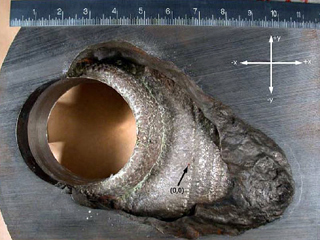
This six-inch cavity in a reactor vessel head, caused by corrosion from leaking reactor coolant (borated water), was discovered at the Davis-Besse Nuclear Power Station in 2002. Metal corrosion is one of many materials science considerations in designing and operating nuclear power systems. (This image by the U.S. NRC is in the public domain.)
Instructor(s)
Prof. Michael Short
MIT Course Number
22.14
As Taught In
Spring 2015
Level
Graduate
Course Description
Course Features
Course Description
In this course, we will lay the foundation for understanding how materials behave in nuclear systems. In particular, we will build on a solid base of nuclear material fundamentals in order to understand radiation damage and effects in fuels and structural materials. This course consists of a series of directed readings, lectures on video, problem sets, short research projects, and class discussions with worked examples. We will start with an overview of nuclear materials, where they are found in nuclear systems, and how they fail. We will then develop the formalism in crystallography as a common language for materials scientists everywhere. This will be followed by the development of phase diagrams from thermodynamics, which predict how binary alloy systems evolve towards equilibrium. Then effects of stress, defects, and kinetics will be introduced. These will all be tied together when developing theories about how radiation, particularly neutrons and heavy charged particles, interact with solid matter to produce defects and evolve microstructure. A few applications of radiation effects will then be treated with this newfound framework, including the change of material properties under irradiation, void swelling, embrittlement, loss of ductility, and the simulation of in-reactor irradiation (neutrons) with heavy ions.


